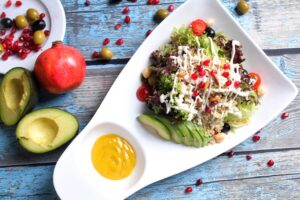What Is Quinoa?

At the start of this module you looked at how pizza, a food that originated in Italy, has become a globalized product in part because of the expansion of American businesses like Domino’s and Pizza Hut opening stores in other countries. Quinoa (pronounced KEEN-wah) has also become a globalized product.
Although Quinoa might look like a grain, it is an edible seed that is native to the Andes region of Peru and Bolivia in South America. It became known as a superfood because it has a higher protein content than wheat, rice, or corn. From 2006 to 2013, the price of quinoa tripled as demand for it grew and more was exported to the United States and Europe. News stories began to circulate that the price had increased so much that locals could no longer afford it.[1] Looking at economic data from Peru, it was evident that those news stories were exaggerated. First, quinoa was not a staple food for locals; that is, they did not depend on it for a large part of their diet. While they bought less when the price went up, they were not driven to buy less nutritious food so their diet did not suffer. In fact, the standard of living in Peru increased during this period of time and the standard of living of those who actually grew quinoa, increased faster compared to those who did not. [2]
Certainly any time that a country experiences high or increasing demand for a product, that is good for their economy. More exports mean that the country’s balance of trade and balance of payments will be more favorable. For emerging markets like Peru and Bolivia, exports are extremely important to growing their economies. Both countries regularly consult with the International Monetary Fund for advice about growth and fiscal policies.[3] Both countries also enlisted the help of the World Bank to improve quinoa production, using environmentally sustainable methods, and to enhance their marketing efforts.[4] This type of assistance furthers the World Bank’s goal of eliminating poverty.
Even though small farmers initially benefited from the higher price of quinoa, large scale producers were attracted to the opportunity to supply the growing demand. These larger producers in Peru and Bolivia began to replace the rice, asparagus, and other crops they were already producing to grow quinoa instead. In addition, Italy, India, and China started to grow quinoa commercially, too. All of this commercial production increased supply and caused prices to fall. The small farmers in the Andes who initially had a monopoly on quinoa production could not compete with larger producers who had more financial capital and better technology.[5]
The next time that you happen to see quinoa in the grocery store, just think about how it could not have gotten there without global trade.
Unintended Consequences
Can you think of other foods or products whose popularity has unintended consequences? Click here to read about how the popularity of strawberries in the winter in Japan has led to most domestic farmers growing berries for winter harvest rather than summer.
What can consumers do to ensure that the popularity of trendy new products do not have undesirable, unintended consequences?
- Blythman, Joanna. “Can Vegans Stomach the Unpalatable Truth about Quinoa?” The Guardian, January 16, 2013. http://www.theguardian.com/commentisfree/2013/jan/16/vegans-stomach-unpalatable-truth-quinoa. ↵
- Cherfas, Jeremy. “Your Quinoa Habit Really Did Help Peru’s Poor. But There’s Trouble Ahead.” NPR, March 31, 2016. https://www.npr.org/sections/thesalt/2016/03/31/472453674/your-quinoa-habit-really-did-help-perus-poor-but-theres-trouble-ahead. ↵
- IMF. “Peru: 2022 Article IV Consultation-Press Release; Staff Report; and Statement by the Executive Director for Peru,” May 11, 2022. https://www.imf.org/en/Publications/CR/Issues/2022/05/11/Peru-2022-Article-IV-Consultation-Press-Release-Staff-Report-and-Statement-by-the-Executive-517828; IMF. “IMF Executive Board Concludes 2022 Article IV Consultation with Bolivia,” September 14, 2022. https://www.imf.org/en/News/Articles/2022/09/14/pr22305-imf-executive-board-concludes-2022-article-iv-consultation-with-bolivia. ↵
- World Bank. “Quinoa: A ‘Superfood’ Enriching the Lives of Andean Farmers,” February 19, 2013. https://www.worldbank.org/en/news/feature/2013/02/19/quinoa-day-from-the-andes-altiplano-to-the-world-international-year. ↵
- NACLA. “The Quinoa Boom Goes Bust in the Andes,” March 12, 2018. https://nacla.org/news/2018/03/12/quinoa-boom-goes-bust-andes. ↵